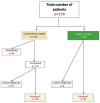A Conservative Combined Laser Cryoimmunotherapy Treatment vs. Surgical Excision for Basal Cell Carcinoma
- PMID: 35743507
- PMCID: PMC9224731
- DOI: 10.3390/jcm11123439
A Conservative Combined Laser Cryoimmunotherapy Treatment vs. Surgical Excision for Basal Cell Carcinoma
Abstract
Surgical excision is the standard treatment for basal cell carcinoma (BCC), but it can be challenging in elderly patients and patients with comorbidities. The non-surgical guidelines procedures are usually regarded as monotherapy options. This quasi-experimental, non-randomized, comparative effectiveness study aims to evaluate the efficacy of a combined, conservative, non-surgical BCC treatment, and compare it to standard surgical excision. Patients with primary, non-ulcerated, histopathologically confirmed BCCs were divided into a conservative treatment (129 patients) and a standard surgery subgroup (50 patients). The conservative treatment consisted of ablative CO2 laser, cryosurgery, topical occlusive 5-fluorouracil, and imiquimod. The follow-up examinations were performed 3 months after remission, then every 3 to 6 months, and were extended with telephone follow-ups. Cosmetic-self assessment was recorded during a telephone follow-up. Subjects from the conservative subgroup presented a clearance rate of 99.11%, and a recurrence rate of 0.98%. No recurrences were recorded in the surgical group, nor during the telephone follow-up. There were no differences regarding adverse events (p > 0.05). A superior self-assessment cosmetic outcome was obtained using the conservative method (p < 0.001). This conservative treatment is suitable for elders and patients with comorbidities, is not inferior to surgery in terms of clearance, relapses, or local adverse events, and displays superior cosmetic outcomes.
Keywords: 5-fluorouracil; CO2 laser; basal cell carcinoma; cryoimmunotherapy; cryosurgery; imiquimod.
Conflict of interest statement
The authors declare no conflict of interest.
Figures





Similar articles
-
Efficacy and safety of laser-assisted combination chemotherapy: A follow-up study of treatment with 5-fluorouracil and cisplatin for basal cell carcinoma.Lasers Surg Med. 2022 Jan;54(1):113-120. doi: 10.1002/lsm.23497. Epub 2021 Dec 5. Lasers Surg Med. 2022. PMID: 34865224
-
A retrospective comparative study of outcome with surgical excision and repair versus nonsurgical and ablative treatments for basal cell carcinoma.Indian J Dermatol Venereol Leprol. 2021 May-Jun;87(3):348-356. doi: 10.25259/IJDVL_170_19. Indian J Dermatol Venereol Leprol. 2021. PMID: 33666033
-
Conventional and combination topical photodynamic therapy for basal cell carcinoma: systematic review and meta-analysis.Br J Dermatol. 2018 Dec;179(6):1277-1296. doi: 10.1111/bjd.16838. Epub 2018 Sep 9. Br J Dermatol. 2018. PMID: 29889302
-
Surgical excision versus imiquimod 5% cream for nodular and superficial basal-cell carcinoma (SINS): a multicentre, non-inferiority, randomised controlled trial.Lancet Oncol. 2014 Jan;15(1):96-105. doi: 10.1016/S1470-2045(13)70530-8. Epub 2013 Dec 11. Lancet Oncol. 2014. PMID: 24332516 Clinical Trial.
-
Basal cell carcinoma: an evidence-based treatment update.Am J Clin Dermatol. 2014 Jul;15(3):197-216. doi: 10.1007/s40257-014-0070-z. Am J Clin Dermatol. 2014. PMID: 24733429 Review.
Cited by
-
Basal cell carcinoma-a clinical indicator of immunosuppression.Front Med (Lausanne). 2024 Mar 14;11:1381492. doi: 10.3389/fmed.2024.1381492. eCollection 2024. Front Med (Lausanne). 2024. PMID: 38549869 Free PMC article.
-
Non-surgical Management of Locally Advanced Basal Cell Carcinoma of the Upper Extremity With Vismodegib.Cureus. 2022 Aug 27;14(8):e28479. doi: 10.7759/cureus.28479. eCollection 2022 Aug. Cureus. 2022. PMID: 36176836 Free PMC article.
-
Squamous Cell Carcinoma In Situ-The Importance of Early Diagnosis in Bowen Disease, Vulvar Intraepithelial Neoplasia, Penile Intraepithelial Neoplasia, and Erythroplasia of Queyrat.Diagnostics (Basel). 2024 Aug 16;14(16):1799. doi: 10.3390/diagnostics14161799. Diagnostics (Basel). 2024. PMID: 39202286 Free PMC article. Review.
-
Basal Cell Carcinoma-A Retrospective Descriptive Study Integrated in Current Literature.Life (Basel). 2023 Mar 19;13(3):832. doi: 10.3390/life13030832. Life (Basel). 2023. PMID: 36983987 Free PMC article.
-
Superficial Basal Cell Carcinoma on the Back Region Treated with a Combination of Cryotherapy and 5% Imiquimod Cream: A Case Report.Int Med Case Rep J. 2023 Jun 26;16:391-396. doi: 10.2147/IMCRJ.S409840. eCollection 2023. Int Med Case Rep J. 2023. PMID: 37398930 Free PMC article.
References
-
- Di Stefani A., Chimenti S. Basal cell carcinoma: Clinical and pathological features. G. Ital. Di Dermatol. E Venereol. Organo Uff. Soc. Ital. Di Dermatol. E Sifilogr. 2015;150:385–391. - PubMed
LinkOut - more resources
Full Text Sources

